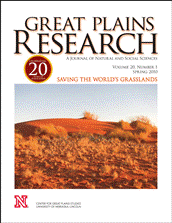Center for Great Plains Studies

Great Plains Research: A Journal of Natural and Social Sciences (through 2013)
Date of this Version
Spring 2006
Document Type
Article
Abstract
Nine years of groundwater monitoring data has documented the important influence that topographic relief and location in the groundwater flow system have on the hydrologic function of interdunal valleys. The western "wet" valley at the Gudmundsen Sandhills Laboratory in central Nebraska, which is a net discharge area, is more strongly buffered from the effects of annual-scale climatic variability than the eastern "dry" valley. The east valley is generally an area of net recharge and as such is more responsive to climatic variability. This study employed a simple water balance approach to estimate evapotranspiration (ET) from water level measurements in the west valley for four specific time intervals in 1998-99 that included growing and senescence periods. The estimates of ET ranged between 5-6 mm/day in the mid-growing season and 2-3 mm/day during the period of senescence.
Included in
Environmental Monitoring Commons, Geomorphology Commons, Hydrology Commons, Other International and Area Studies Commons, Water Resource Management Commons


Comments
Published in Great Plains Research 16:1 (Spring 2006). Copyright © 2006 The Center for Great Plains Studies, University of Nebraska – Lincoln. Used by permission.